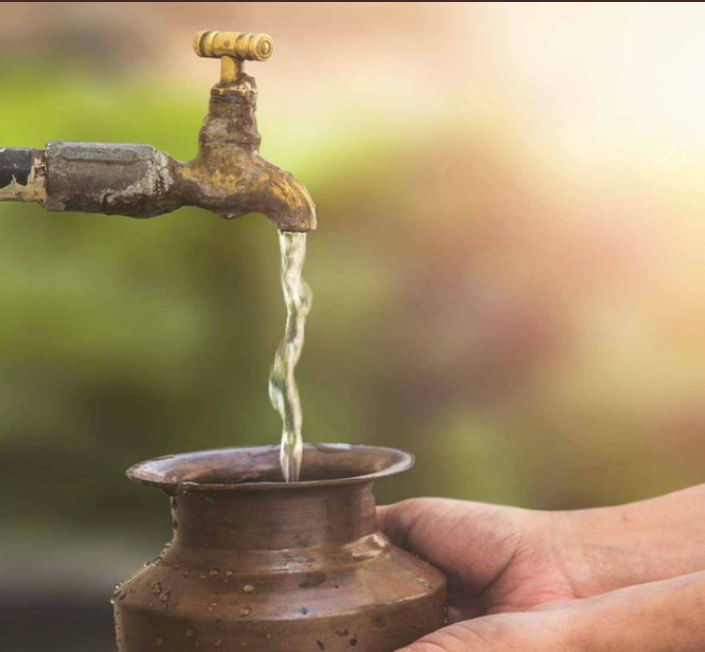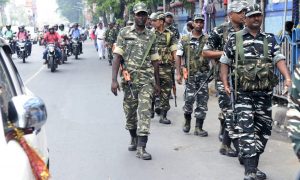India has been experiencing chronic water scarcity due to persistent droughts and shifting weather patterns. India only has 4% of the world’s freshwater resources despite having 16% of the world’s population. With a 25% share of the global total, India has surpassed all other countries as the greatest groundwater extractor. Our major rivers are dying as a result of pollution, and over 70% of our water sources are polluted.
In response to these growing concerns about water scarcity, Prime Minister Narendra Modi announced the Jal Jeevan Mission – ‘Har Ghar Jal’ on August 15, 2019, the day India celebrated its 73rd Independence Day. By establishing the Ministry of Jal Shakti, the central government attempted to combine all departments and ministries that dealt with water issues to concentrate solely on resolving India’s water challenges. Jal Jeevan Mission (JJM) – Har Ghar Jal, the ministry’s flagship programme, aimed to deliver clean and adequate drinking water to all rural Indian homes through individual household tap connections by 2024.
Some of the significant components of the Jal Jeevan Mission:
Tap water supply
Water quality ensuring safe drinking water to reduce water-borne ailments
Community engagement in planning
Promote groundwater recharge & water conservation
Greywater management
Women empowerment
Skill development & employment generation
Focus on the future generation
52.20% of rural households have the provision of tap water supply in their homes
At the time of the Jal Jeevan Mission’s inception, barely 3.23 million rural families, or 17% of the rural population, had access to drinking water from taps. Women and young girls bore the brunt of arranging water for everyday household needs. Women, particularly in rural areas, often go for miles to get water from the nearest source. There is enough data to demonstrate that school attendance among girls was much lower during the summer when repeated travel was required due to increasing water demand. Significant progress has been seen in this area since the introduction of the Jal Jeevan Mission and the improvement in access to tap water connections, and now on 3 years of Jal Jeevan Mission, as on 10 August 2022, out of total 19.32 crore rural households in the country, 9,99,43,358 (52.20%) households have the provision of tap water supply in their homes.
India’s primary user of water stock is agriculture. 80 to 90% of the drinking water needs in rural India are met by groundwater resources. What is concerning is that groundwater levels in India dropped by more than 60% between 2007 and 2017, and that about 90% of the extracted water is used for agriculture. According to a 2019 NITI Aayog report, India is experiencing the biggest water crisis in its history and about 600 million people lack access to clean water. However, in keeping with Prime Minister Narendra Modi’s aim of providing clean drinking water to every rural household, the country has reached the milestone of 50% rural households having access to tap water connections. Goa, Telangana, the Andaman and Nicobar Islands, D&N Haveli and Daman & Diu, Puducherry, and Haryana have already attained 100% home connectivity. Punjab, Gujarat, Himachal Pradesh, and Bihar have more than 90% coverage and are rapidly approaching the ideal of ‘Har Ghar Jal.’
Jal Jeevan Mission is based on a community approach
The programme will also implement source sustainability measures as mandatory elements, such as recharge and reuse through grey water management, water conservation, and rainwater harvesting. The Jal Jeevan Mission is based on a community approach and includes extensive information, education, and communication as a key component of the mission.
In order to ensure that skilled manpower is available in every village, for quick water supply, regular operation, and maintenance tasks, local youth are trained as masons, plumbers, electricians, motor mechanics, pump operators, etc. Additionally, this has given local youth in the villages new job opportunities in water supply infrastructure development, operation and maintenance, and water conservation. Five people, mostly women, are taught in each village about different elements of potable water and how to utilise Field Evaluate Kits (FTKs) to test the quality of the water supplied, carry out sanitary surveys, and submit the data on the JJM portal. More than 7 lakh women have received FTK training to date. All of these cutting-edge initiatives are consistent with Mahatma Gandhi’s concept of “Gram Swaraj,” which vests decision-making authority in the village community. Jal Jeevan Mission has evolved into a Jan Andolan with the active engagement of individuals, particularly women, and rural communities working together.
Drinkable tap water has been made available to 8.46 lakh schools
Prime Minister Narendra Modi declared a 100-day campaign, which was begun by the Union Minister for Jal Shakti, Gajendra Singh Shekhawat, on October 2, 2020, to safeguard children’s health and wellbeing by supplying clean tap water in schools and Anganwadi centres across the nation. In just 16 months, drinkable tap water has been made available to 8.46 lakh schools (82%) and 8.67 lakh (78%) Anganwadi centres across the nation for drinking, cooking, handwashing, and bathroom use. In schools across the nation, 93 thousand rainwater harvesting facilities and 1.08 lakh grey water reuse structures have been developed.
Jal Jeevan Mission makes use of technology to ensure service delivery, transparency, accountability, and efficient use of resources. Each water supply asset developed as part of the Jal Jeevan Mission has a geo-tag. When developing a single village project to locate drinking water sources and build an aquifer recharge structure, hydro-geo morphological (HGM) maps are used.
Budget allocated to begin the Jal Jeevan Mission (Urban)
Finance minister Nirmala Sitharaman, allotted Rs 2,87,000 crore to the Ministry of Jal Shakti in the 2021–22 budget to begin the Jal Jeevan Mission (Urban), which will ensure that all 4,378 localities have access to the universal water supply. Although it is a noble goal in itself, the decline in the supply of drinkable water should be also addressed. The public at large, the commercial sector, and especially the civil society must work together to overcome the water crisis because the government cannot handle it on its own.
Jal Jeevan Mission’s motto, “No one is left out”
Jal Jeevan Mission, in contrast to prior water supply initiatives, places more emphasis on delivering water services than just constructing water supply infrastructure. The Jal Jeevan Mission’s motto, “No one is left out,” ensures that every household, regardless of socioeconomic position, has access to running water. The Mission is giving rural families greater comfort of living as well as pride and dignity.




























 WhatsApp us
WhatsApp us
Pingback: over here
Pingback: buy Changa Dmt online Italy,
Pingback: niches youtube
Pingback: ทดลองเล่นสล็อต lsm99